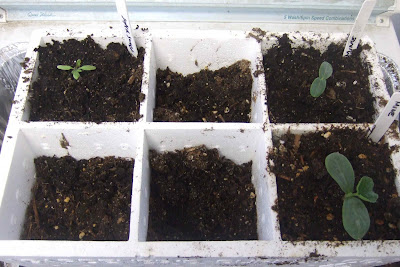My Grow Light enables me to start my seeds two to three months earlier than I would otherwise. This means that I can eat Cherry Tomatoes in May and have bigger size Winter Melons and Pumpkins.
However, the Grow Light is cheap. In addition to a couple of hundred dollars it cost me to buy my Grow Light system (4 T5 bulbs, each 4 feet long) , there is also the monthly charge for electricty. After a very short while, the monthly costs can quickly exceed the original cost of the Grow Light.

Using a device called the
Kill-A-Watt , I can measure how much electricty my Grow Light uses.
When I connected the Grow Light to the Kill-A-Watt, I found the Grow Light costs $0.0483 per hour to run. That's less than a nickel an hour. That may not seem like a lot, but if I were to run the Grow Light for 24 hours per day, 7 days a week, it would cost me $34.78 a month or $423 a year!!!
I only leave the Grow Light on for 12 hours a day (6:30pm to 6:30am) and I only use it in January and February, so my annual cost is only $34.78. Once March comes, I can put the seeds outside and they germinate just fine. Similarly, I can put the seedlings outside in March without any problems.
There are also cheaper ways to run the Grow Light. I could have gone with 2 bulbs and/or with 2 foot long bulbs. This would have cut my monthly cost down by 50% to 75%.
Alternatively, I could forego the Grow Light and just buy Cherry Tomato plants from the local nursery and start the Winter Melon and Pumpkin seeds in March. But I find that the local nurseries don't stock the Cherry Tomato plants that my family likes to eat and I like having huge Winter Melons and Pumpkins. I am willing to pay $35 a year for that luxury. Of course, if I hadn't already spent the money on the Grow Light, I might feel differently.












 This is the fastest I have ever had a Winter Melon seedling grow. At this rate, I will have to transplant the seedling into the ground by February 1 (about 1 month earlier than I planned).
This is the fastest I have ever had a Winter Melon seedling grow. At this rate, I will have to transplant the seedling into the ground by February 1 (about 1 month earlier than I planned).











